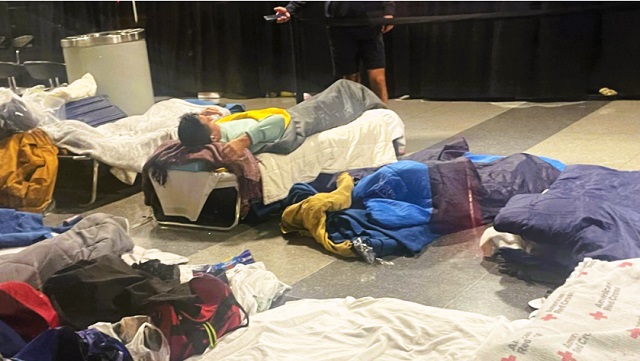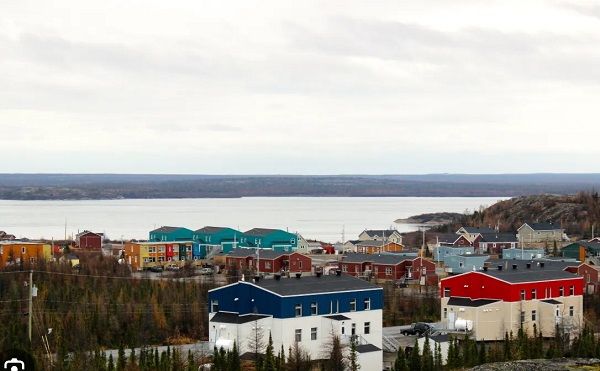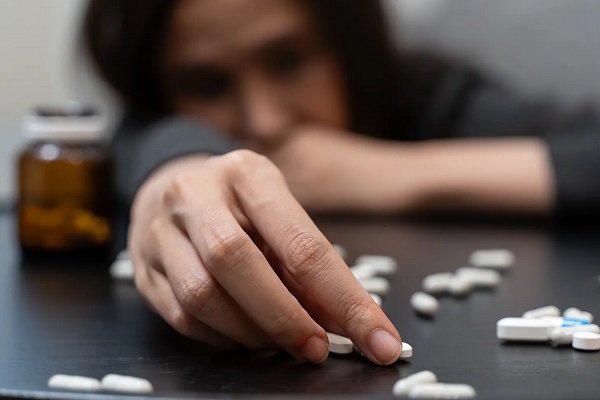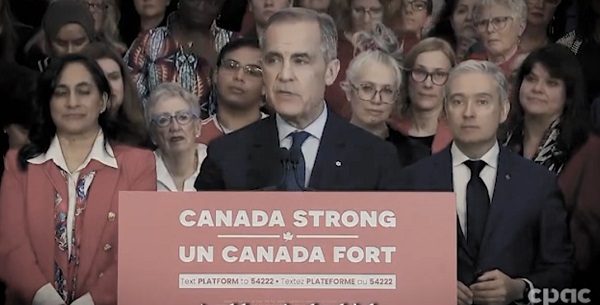Economy
‘What constitutes a border crisis?’ Sanctuary cities have found out

Migrants and migrant bedding inside O’Hare International Airport in Chicago.
From The Center Square
By Tom Gantert
Yeah, you liked them when it wasn’t your problem because you’re not a border state. And then when they show up in Chicago and New York, you’re like ‘What the [expletive] are we going to do with these people?’”
In March 2021, the Los Angeles Times published a story with a headline that asked, “What constitutes a border crisis?”
The story quoted then House Republican Leader Kevin McCarthy as saying, “There is no other way to claim it than a Biden border crisis.”
Then the LA Times asked, “But is it a crisis?”
Just a month later in April 2021, New York City Mayor Bill de Blasio released a statement about his city being a sanctuary city.
“New York City is proud to be a welcoming and inclusive city for immigrants,” de Blasio said at the time.
The debate in the U.S. on migrants took off in April 2022 when Texas Gov. Greg Abbott decided to take a stand against President Joe Biden and what Abbott called an open border policy.
Abbott stated that Biden’s repeal of Title 42 – a pandemic-era policy that allowed the government to quickly expel arriving asylum seekers – had created an “unprecedented surge of illegal aliens” into the country with as many as 18,000 apprehensions a day.
Abbott said that Texas border towns were being overrun by migrants and were overwhelmed. His solution was to bus many of the arriving migrants to sanctuary cities across the U.S.
In August 2022, when the first bus of migrants leaving Texas arrived in New York, Abbott was clear why he had his state paid for the trip. New York had a new mayor by then.
“New York City is the ideal destination for these migrants, who can receive the abundance of city services and housing that Mayor Eric Adams has boasted about within the sanctuary city,” Abbott stated in a news release. “I hope he follows through on his promise of welcoming all migrants with open arms so that our overrun and overwhelmed border towns can find relief.”
And just over a year later, New York Gov. Kathleen Hochul was on CNN in September 2023 pleading with immigrants to “go somewhere else.”
How it has played out was not lost on liberal comedian Bill Maher.
“Could everyone just stop the posturing?” Maher said on a July 2023 podcast with Sharon Osbourne. “Don’t pretend that you love migrants so much and then when we send them to you, you don’t like them. You know? You’re full of [expletive]. And we can see that. Yeah, you liked them when it wasn’t your problem because you’re not a border state. And then when they show up in Chicago and New York, you’re like ‘What the [expletive] are we going to do with these people?’”
New York wasn’t the only destination for Abbott’s buses. He also targeted other sanctuary cities, such as Washington, D.C, Chicago and Denver.
The New York Times published an article in July 2023 that had a headline that asked, “Is Texas’ Busing Responsible for the Migrant Crisis Across Cities?”
On June 14, Abbott’s office stated that it had bused 119,200 migrants to six sanctuary cities since August 2022. That included 45,700 migrants to New York City and 36,900 migrants to Chicago since August 2022. There were also 19,200 migrants bused to Denver since May 2023 and 12,500 migrants bused to Washington D.C. since April 2022.
But Abbott wasn’t alone in busing migrants from the border to locations throughout the country. The Democratic-run city of El Paso also bused migrants north.
Democratic Arizona Gov. Katie Hobbs stated in September 2023 that Arizona was “overwhelmed” by the flow of migrants into her state. Arizona spent $10.5 million transporting 10,247 migrants out of state as of September 2023.
That’s just part of a bigger surge of migrants into the U.S. Since Biden took office in January 2021, about 12 million illegal border crossings have been documented, according to U.S. Customs and Border Protection data and a compilation of “gotaway” data obtained from border agents by The Center Square. Gotaways is the official CBP term to describe those who illegally crossed the border between ports of entry but who were not apprehended. CBP does not publicly release “gotaway” data.
The increase in migrants has hammered the budgets of sanctuary cities.
Washington, D.C. created an Office of Migrant Services with an initial start-up cost of $10 million in 2022. In 2025, the city budgeted $39 million for that office.
Chicago has spent $299 million on migrants since 2022, according to a March 2024 report by the Illinois Policy Institute, and that does not include the hundreds of millions of dollars state taxpayers have paid for costs such as migrant health care.
New York City Mayor Adams said in August 2023 the migrant crisis may cost his city $12 billion over three years.
The city of Denver stated in April 2024 that the increase in migrants has cost it $63 million.
The cost to taxpayers in the state of Texas was $13.4 billion in 2023, according to the Federation For American Immigration Reform. Only California had a higher cost at $30.9 billion.
Ira Mehlman, spokesman for the Federation For American Immigration Reform, said Abbott’s busing strategy has worked.
“His busing policy exposed the hypocrisy of many sanctuary jurisdiction politicians who extolled the virtues of mass immigration regardless of its legality, but are not so happy when they actually have to deal with the real impact of large numbers of migrants,” Mehlman said in an email to The Center Square. “So long as it was someone else’s problem, they were happy to virtue signal and criticize others. Once it became their problem, they demanded that Abbott and others stop sending them migrants. For years, these sanctuary proponents claimed that illegal aliens were a benefit to the country, but are now demanding federal assistance to manage to cover their costs, exposing the fact that illegal immigration imposes huge fiscal costs.”
Tom Gantert
Managing Editor
Economy
The Net-Zero Dream Is Unravelling And The Consequences Are Global

From the Frontier Centre for Public Policy
The grand net-zero vision is fading as financial giants withdraw from global climate alliances
In recent years, governments and Financial institutions worldwide have committed to the goal of “net zero”—cutting greenhouse gas emissions to as close to zero as possible by 2050. One of the most prominent initiatives, the Glasgow Financial Alliance for Net Zero (GFANZ), sought to mobilize trillions of dollars by shifting investment away from fossil fuels and toward green energy projects.
The idea was simple in principle: make climate action a core part of financial decision-making worldwide.
The vision of a net-zero future, once championed as an inevitable path to global prosperity and environmental sustainability, is faltering. What began as an ambitious effort to embed climate goals into the flow of international capital is now encountering hard economic and political realities.
By redefining financial risk to include climate considerations, GFANZ aimed to steer financial institutions toward supporting a large-scale energy transition.
Banks and investors were encouraged to treat climate-related risks—such as the future decline of fossil fuels—as central to their financial strategies.
But the practical challenges of this approach have become increasingly clear.
Many of the green energy projects promoted under the net-zero banner have proven financially precarious without substantial government subsidies. Wind and solar technologies often rely on public funding and incentives to stay competitive. Energy storage and infrastructure upgrades, critical to supporting renewable energy, have also required massive financial support from taxpayers.
At the same time, institutions that initially embraced net-zero commitments are now facing soaring compliance costs, legal uncertainties and growing political resistance, particularly in major economies.
Major banks such as JPMorgan Chase, Citigroup and Goldman Sachs have withdrawn from GFANZ, citing concerns over operational risks and conflicting fuduciary duties. Their departure marks a signifcant blow to the alliance and signals a broader reassessment of climate finance strategies.
For many institutions, the initial hope that governments and markets would align smoothly around net-zero targets has given way to concerns over financial instability and competitive disadvantage. But that optimism has faded.
What once appeared to be a globally co-ordinated movement is fracturing. The early momentum behind net-zero policies was fuelled by optimism that government incentives and public support would ease the transition. But as energy prices climb and affordability concerns grow, public opinion has become noticeably more cautious.
Consumers facing higher heating bills and fuel costs are beginning to question the personal price of aggressive climate action.
Voters are increasingly asking whether these policies are delivering tangible benefits to their daily lives. They see rising costs in transportation, food production and home energy use and are wondering whether the promised green transition is worth the economic strain.
This moment of reckoning offers a crucial lesson: while environmental goals remain important, they must be pursued in balance with economic realities and the need for reliable energy supplies. A durable transition requires market-based solutions, technological innovation and policies that respect the complex needs of modern economies.
Climate progress will not succeed if it comes at the expense of basic affordability and economic stability.
Rather than abandoning climate objectives altogether, many countries and industries are recalibrating, moving away from rigid frameworks in favour of more pragmatic, adaptable strategies. Flexibility is becoming essential as governments seek to maintain public support while still advancing long term environmental goals.
The unwinding of GFANZ underscores the risks of over-centralized approaches to climate policy. Ambitious global visions must be grounded in reality, or they risk becoming liabilities rather than solutions. Co-ordinated international action remains important, but it must leave room for local realities and diverse economic circumstances.
As the world adjusts course, Canada and other energy-producing nations face a clear choice: continue down an economically restrictive path or embrace a balanced strategy that safeguards both prosperity and environmental stewardship. For countries like Canada, where natural resources remain a cornerstone of the economy, the stakes could not be higher.
The collapse of the net-zero consensus is not an end to climate action, but it is a wake-up call. The future will belong to those who learn from this moment and pursue practical, sustainable paths forward. A balanced approach that integrates environmental responsibility with economic pragmatism offers the best hope for lasting progress.
Marco Navarro-Genie is the vice president of research at the Frontier Centre for Public Policy. With Barry Cooper, he is coauthor of Canada’s COVID: The Story of a Pandemic Moral Panic (2023).
Alberta
CPP another example of Albertans’ outsized contribution to Canada

From the Fraser Institute
By Tegan Hill
Amid the economic uncertainty fuelled by Trump’s trade war, its perhaps more important than ever to understand Alberta’s crucial role in the federation and its outsized contribution to programs such as the Canada Pension Plan (CPP).
From 1981 to 2022, Albertan’s net contribution to the CPP—meaning the amount Albertans paid into the program over and above what retirees in Alberta received in CPP payments—was $53.6 billion. In 2022 (the latest year of available data), Albertans’ net contribution to the CPP was $3.0 billion.
During that same period (1981 to 2022), British Columbia was the only other province where residents paid more into the CPP than retirees received in benefits—and Alberta’s contribution was six times greater than B.C.’s contribution. Put differently, residents in seven out of the nine provinces that participate in the CPP (Quebec has its own plan) receive more back in benefits than they contribute to the program.
Albertans pay an outsized contribution to federal and national programs, including the CPP because of the province’s relatively high rates of employment, higher average incomes and younger population (i.e. more workers pay into the CPP and less retirees take from it).
Put simply, Albertan workers have been helping fund the retirement of Canadians from coast to coast for decades, and without Alberta, the CPP would look much different.
How different?
If Alberta withdrew from the CPP and established its own standalone provincial pension plan, Alberta workers would receive the same retirement benefits but at a lower cost (i.e. lower CPP contribution rate deducted from our paycheques) than other Canadians, while the contribution rate—essentially the CPP tax rate—to fund the program would likely need to increase for the rest of the country to maintain the same benefits.
And given current demographic projections, immigration patterns and Alberta’s long history of leading the provinces in economic growth, Albertan workers will likely continue to pay more into the CPP than Albertan retirees get back from it.
Therefore, considering Alberta’s crucial role in national programs, the next federal government—whoever that may be—should undo and prevent policies that negatively impact the province and Albertans ability to contribute to Canada. Think of Bill C-69 (which imposes complex, uncertain and onerous review requirements on major energy projects), Bill C-48 (which bans large oil tankers off B.C.’s northern coast and limits access to Asian markets), an arbitrary cap on oil and gas emissions, numerous other “net-zero” targets, and so on.
Canada faces serious economic challenges, including a trade war with the United States. In times like this, it’s important to remember Alberta’s crucial role in the federation and the outsized contributions of Alberta workers to the wellbeing of Canadians across the country.
-

 Alberta2 days ago
Alberta2 days agoProvince to expand services provided by Alberta Sheriffs: New policing option for municipalities
-

 Bruce Dowbiggin1 day ago
Bruce Dowbiggin1 day agoIs HNIC Ready For The Winnipeg Jets To Be Canada’s Heroes?
-

 2025 Federal Election1 day ago
2025 Federal Election1 day agoCSIS Warned Beijing Would Brand Conservatives as Trumpian. Now Carney’s Campaign Is Doing It.
-

 Alberta1 day ago
Alberta1 day agoMade in Alberta! Province makes it easier to support local products with Buy Local program
-

 2025 Federal Election2 days ago
2025 Federal Election2 days agoNo Matter The Winner – My Canada Is Gone
-

 Health1 day ago
Health1 day agoHorrific and Deadly Effects of Antidepressants
-

 2025 Federal Election1 day ago
2025 Federal Election1 day agoCampaign 2025 : The Liberal Costed Platform – Taxpayer Funded Fiction
-

 2025 Federal Election1 day ago
2025 Federal Election1 day agoA Perfect Storm of Corruption, Foreign Interference, and National Security Failures

